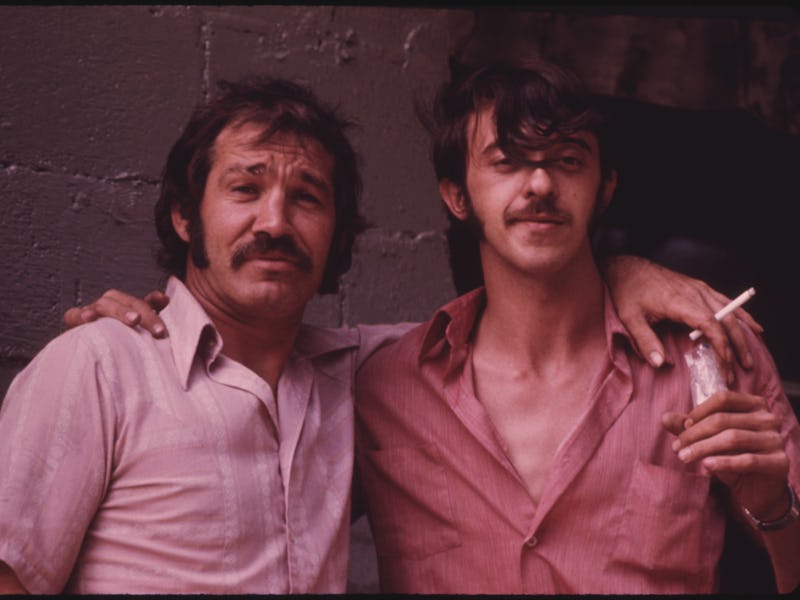How Hometown Heroes Became Villains
To stay home is to stay -- to one degree or another -- ignorant.

In the wake of Donald Trump’s election, Americans are engaged in a heated conversation about race and geography. There are certain parts of the country where white nationalist beliefs have taken hold and certain parts of the country where the very idea of racialist rhetoric is greeted with naive surprise and horror. Blue and red maps may show something about racism in America, but beliefs are truly located in the brain and different sorts of life experiences create different sorts of brains. Migration is key to this process so it’s helpful to understand how moving — or not — tends to change minds.
Though many on the left — notably liberal icon Jon Stewart — have argued that it’s unfair to call everyone who voted for Trump a racist, that statement has proven contentious. A significant portion of the commentariat has rebutted that voting for someone who says racists things and seeks to employ racist people is an act of racism. Either way, it’s clear that racism can and has been stoked but didn’t come about during the Republican Party primary.
So where does it come from? An October poll conducted by The Atlantic and the Public Religion Research Institution found that 40 percent of Trump voters were likely to still live in their hometown, compared to 29 percent of people who voted for Hillary Clinton. White people who never left their hometown were determined as the most likely to vote for Trump, an effect that PPRI director of research Daniel Cox said was likely related to how homogenous and insular those hometowns had become.
Geographic mobility, however — getting away from your hometown — is what leads to more heterogeneous interactions and is statistically associated with greater ethnic tolerance. An in-group, a grouping of people with a shared identity, is likely to be less prejudiced against another in-group when contact with that group is increased. When the factors of travel and meeting are decreased, intolerance emerges.
“One implication is that there is a vicious circle — intolerance leads to lower intergroup interaction, which in turn leads to more intolerance,” John Berry, a professor emeritus at Queen’s University tells Inverse. “This is a message that needs to be promoted, now that the political message is ‘make my nation small again,’ as in the United Kingdom and the United States.”
Just as racism isn’t limited to those who don’t move, it isn’t non-existent among those who do. But it is true that exposure to different sorts of people tends to stop the development of racism. Ethnocentrism is hard to pull off while moving around and engaging with other cultures.
According to Jim Neuliep, a professor at St. Norbert College who helped develop the Generalized Ethnocentrism scale, ethnocentrism is a natural condition that exists on a continuum from low to high. It’s a natural condition; a universal phenomenon. What matters less is that you are ethnocentric, and more how ethnocentric you are — on the low end you’re patriotic and at the high end it’s ethnic cleansing. Factors that affect how ethnocentric people are include: the size of their hometown, how frequently they travel outside their home state, the number of people in their hometown of the same race, their frequency of contact with people from other countries, and their frequency of contact with people from different races.
Exposure to other races is likely why urbanism is a noticeable predictor of tolerance — there’s a difference in how staying in your hometown will affect you if you grew up in a small, rural community versus a metropolis. A 2014 University of Oxford study found that levels of racial prejudice among white people dropped when they lived in ethnically mixed communities. These people didn’t even have to directly interact with minorities — they just had to see white strangers doing so. This result was determined from nine years of survey data across Europe, the United States, and South Africa.
“We have shown that positive contact between people belonging to different ethnic groups leads to more tolerant societies overall,” senior author Miles Hewstone said in a statement. “It isn’t even confined to those whose friends have contact with minorities. Simply living in a neighborhood where other people are mixing with minorities is enough to reduce racial prejudice.”
Hewstone and his team argue that governments should instigate social interventions to increase contact between groups to ensure that prejudice is not just reduced in individuals “but throughout entire neighborhoods.” How realistic the enactment of this sort of solution would be under a Trump administration remains to be seen.
But it’s undeniable that racism is the United States is as obvious as a comment section and as systematically pervasive as the integral components from which it is wrought. According to a 2012 poll conducted by the American National Election Studies, an estimated 62 percent of white Americans ranked black people, as a whole, lower on a scale of positive attributes in comparison to white people. That’s a 17 percent jump from when the same poll was conducted in 2008.
In this election, Trump won the white vote and the immobile vote. Those aren’t the same vote, but they overlap and where they do, racism thrives.